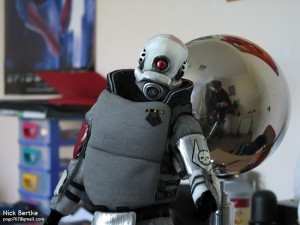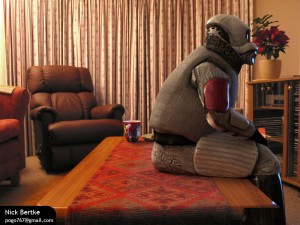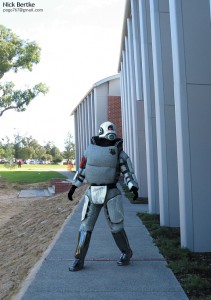Paul Debevec opened his talk at SIGGRAPH 2005 by showing some images created by teenager Nick Bertle who had used HDR to have his favourite Half Life characters rock up at his place and hang out. Bertle has fast become a phenomenom for his work in HDR — all before he has left high school. fxguide caught up with him to discuss HDR CGI for part 3 of our “Away from Live Action” series.
3D is a cornerstone of visual effects – so for the CGI version of our “Away from Live Action” series we wanted to find a very unusual CGI story, and none we found is more remarkable than the work of this school boy from Perth – Nick Bertle. His work is nothing short of inspirational for young animators anywhere.
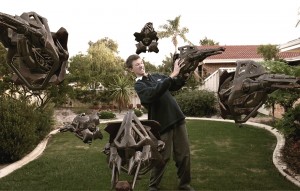
fxg: Nick, your work has generated a lot of interest, what do you think is generating the interest – is it the quality of the photoreal output, the use of HDR, the fact that characters came from a game – or that you’re relatively young?
I think you’ve summed most of the reasons up already! They’re obviously attracting a huge amount of people from the gaming community, the thread at the Facepunch forums have already shot up over the 700,000 views mark. People seem to be excited about the realism which is achieved, and even further excited about the strong possibility that this sort of realism could be achieved in real-time with a graphics card in the near future. I suppose the quality of the image plays a small part in all the hype, but I really think it’s the illusion of a Half-Life 2 character standing in my house, backyard or driveway that gets people looking. What’s keeping the hype going, though, is the gamer’s sudden desire to try this out themselves, and that is exactly what’s happening. The thread at the Facepunch forum is now packed with people posting their own attempts, and that’s definitely what is keeping that thread alive.
fxg: In your experience what really sells a shot?
I’d have to say it is the realism and content of the shot which scores big. But of course, super-realistic shots where a Soldier is simply standing in the middle of a room has been to absolute death, so realism and content really have to go together. Big scenes, like a sci-fi war in the middle of an every-day street, that sort of stuff seems to get the most wows. There are many shots I’ve done lately which have come out looking totally realistic, but they are merely lighting tests, and that is why I don’t post them. A synthetic dinosaur model on my coffee table doesn’t sell anymore! I think the bars are rising as people are learning more, and shots need to have more in them in order to deliver a big impact. But what really grabs my eye now-a-days is the realism of the shot as well as what is going on in it, like how synthetic characters or objects are interacting with real ones. That is what really intrigues me and is ultimately what got me started doing this in the first place!
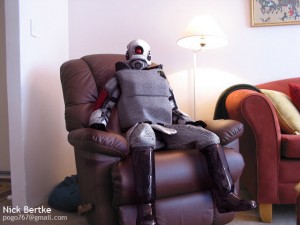
fxg: How great has the response been from the work you have posted?
It is been absolutely mind blowing. I continuously receive compliments and questions through Email even today. I didn’t expect any of this at all. I just wanted to show everyone what games could look like in the future, and I thought Half Life 2 had models and textures which were far beyond worthy. So off I went to post these pictures of mine and suddenly I started getting hits and views from all sorts of places on the net. The group and I were actually starting getting worried!
fxg: Can you discuss the story of Seven Hour War? What is the nature of the actual story…?
To put it as bluntly as possible, SHW is about a group of orphans caught in the break of the Seven Hour War who escape from the Combined forces and shine faith and hope onto the people of their lost city. The majority of the story involves plenty of action, fighting between the zombies, Combine and humans, but also has a strong thread of friendship and family throughout. We’ve all agreed that no matter how action-packed a movie is, it needs good characters and a good story in order to really survive. One of the key events of SHW is the capture of Bill, a close friend of the group who is taken away by the Combine to be transformed into a Stalker along with the rest of the human race. The transformation fails at every attempt the Combine makes, until eventually they give up in confusion and throw him into a cell to die. Most of the film will resolve around the kids getting Bill back and reaching their ultimate goal which is to escape the city and take as many people as they can.
Tthe film will most likely have a fair amount of gore or what have you, so the target audience will probably fall around the 16 years and over mark. We’re really after people our age, mostly HL2 and Sci-Fi lovers.
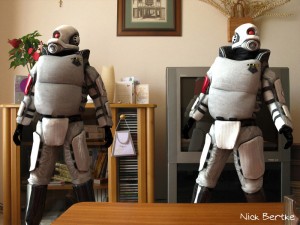
fxg: Who else is involved in Seven Hour War?
Josh Young is our head story writer, Luke Mundy is our manager, Mat Fuller is our props designer, and Ryan McCalla is currently our only animator. Our jobs are all very free-for-all at the moment because we have very few people and school work is coming down on us by the truck load. We’re still looking for people to help us with animation for when the time comes, and re-texturing would also be great.
We hear that games now out sell Hollywood. Are Games or Feature films of more interest to you professionally?
It is hard to say, I see them as two different things. With feature films, you are kicking back and watching everything. With games, you are in control. When it comes down to it I suppose I’m more interested games. Call me crazy if you like but I think movies are starting to get boring and over rated, there is just nothing new anymore. Most of the movies I’ve seen lately are just your typical mindless action movies, and I mean, who can honestly say they haven’t seen at least 20 of those in their life time? Movies need to do something new if you ask me. Almost everything in the movies has been done already, but games on the other hand still have plenty of new paths to explore. So yeah, I get more excited about a new computer game than another movie which I’ll forget about in a day or two.
fxg: You have said that people have been bugging you about how to do the sort of HDRi work your doing,… but how did you learn?
I learnt mostly from trying things out. Naturally I dug into a few help files and tutorials here and there, but the majority of my learning came from just experimenting. I found the whole thing so intriguing that it just kept me going to learn more, I constantly wanted to reach that next hurdle on the horizon. Most of the time, if I simply could not find out how to do something, I’d try finding an answer or tutorial over Google, that usually got me what I was looking for. But I firmly believe that experience is the best way to learn. Reading a book can only teach you so much.
fxg: What are some of your favourite sources of info?
The site I visit the most about this whole process is Paul Debevec’s website. It is packed with new and interesting projects of his, and a lot of what I’ve learnt has come from his site. That is probably about it, if there is absolutely anything else, it would have to be the 3DSMax help file!
fxg: What gear do you use?
?GCFScape, VPK Tools, MDL Decompiler, HDRSHOP, 3DSMax SMD importer plugin, and of course 3DS, – with image probes as HDR images @1024×768.On a 3.0ghz HT, 1024MB DDR, a Sapphire Radeon 9600XT 256MB, and a Canon Powershot G2.
Do you use HDR shop 2? or Something else?
I use the first version of HDRShop. If I were doing this for a professional job, I would probably consider purchasing version 2.
fxg: Do you shoot Spheres or Fisheye shots for your image probe files?
I photograph a reflective sphere. I unfortunately don’t have access to a fisheye lens!
fxg: How do you rate the HDR included now in CS2?
It’s okay. In no way does it compete with HDRShop in my opinion, the functions in CS2 are very generic and are aimed at people who are less experienced with HDR images. For example, the calibration of your camera’s gamma curve is unavoidably done automatically, and then of course the freedom to transform the image isn’t anywhere near as broad as it is in HDRShop. I wouldn’t choose CS2 as my primary HDR image-editing program; HDRShop all the way. HDRShop does everything I need it to do.
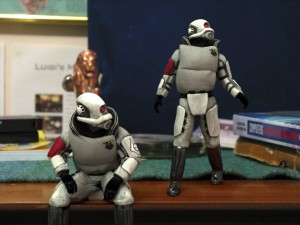
fxg: Which Max renderers do you like?
My favorite is Splutterfish’s Brazil. Mental Ray is definitely my second choice, but above all, Brazil is on the top of my list easily. It’s always produced the most realistic images for me, and that’s always what I’m after. Mental Ray 3.4 has introduced an adjustable “bounce count”, so now you can change how many times light can bounce in your scene with Mental Ray. This drew my attention back to Mental Ray, because the lack of this feature in the previous MR versions was what had me switch to Brazil. Still, even with the addition of this feature, I still find that Brazil outputs the greatest realism I’ve ever seen.
fxg: What do you composite in ? Is it just Photoshop so far or have you done many moving shots?
I mostly composite in Photoshop. If I do any moving shots, I track the camera movement using Boujou and export the camera movement into 3DSMax. If any further composition work is required (which is surprisingly rare), I use AfterEffects or Combustion to get the job done.
What drew you to creating HDRI specifically? Why not use some other lighting method?
My biggest goal is to make it look like synthetic characters or objects are really there, and HDRI-based lighting is the only real way you can do that efficiently. Trying to imitate the lighting conditions of a scene with nothing but Omnis and Spotlights is not something I’d want to get tangled up in. An omni-directional HDR image is perfect; it contains the light from all angles in the scene in just one shot. All that’s left to do then is adjust the brightness, maybe a few colors as well, and you’re ready to roll.
HDRi is certainly very powerful – do you do much non HDRi rendering ?
Nope! I’d say 90% of the stuff I do now a days uses HDRI-based lighting. I never find the need to do it any other way. Even my product designs are rendered with HDRI-based lighting. Mind you, there’s always the need for a certain spotlight or omni with things like that, in which case I tone the HDR image down.
fxg: Do you remove your reflection in your image probe HDRs?
I don’t usually remove my reflection anymore. It’s too much of a hassle, I just leave it in there, even when doing a double-sided probe (which is the only case in which you can remove artifacts like that.) The way you remove yourself from the probe is to take two shots, one of one side of the sphere and another of the side 90 degrees around. You then use HDRShop (or something similar) to identify points in each side, which show HDRShop how the camera has rotated for each angle. Then it’s a case of merging the two together using these points, and drawing a mask in Photoshop which you import into HDRShop to show it what parts of what side to get rid of and so on. It’s a complicated process to explain in any further detail than that, so I hope this explains enough.
fxg: What’s the biggest problem in making the HDR image probes?
At the moment, for me it’s getting the front and side images correctly aligned. I often end up with the images not coming together correctly and therefore the probe is far from perfect.
fxg: What games excite you technically right now – either on the market or coming soon?
Black & White 2, without a doubt. I can’t wait for it. UT2006 also looks awesome, and Quake 4 looks pretty amazing. I don’t really get excited about a game’s technical side though, I find that graphics are usually the last thing running through my mind when being chased through an abandoned village by crazy zombies at night. Not to say good graphics don’t make a difference, but I find they just make the game look awesome without you having to think about that.
HOW TO DO IT YOURSELF
Australian Nick Bertke came up with a cool idea: What if you could place those life-like character models from Half-Life 2 into real-life photos? Through a series of posts at the Garry’s Mod forums of Facepunch Studios, he detailed a process that resulted in some amazing images. If you’d like to try it yourself, here is a previous published list of ‘how-to’ based on Bertke’s posts as well as other tutorials.
This information below is based on previously published web info on various sites.
The programs Nick used:
GCFScape extracts Half-Life 2 models from GCF files
MDLDecompiler decompiles Half-Life 2 models into SMD files so you can import them into 3D Studio Max
VPK-Tool converts Valve’s texture files into TGA files, so that you can properly apply the Model’s texture.
SMD Importer is a 3D Studio Max plugin that lets you import SMD files (Half-Life 2 models).
3ds Max 7 (Free 30-Day Trial)
HDR Shop (ver. 1.0)
Half-Life 2 and the Half-Life 2 SDK from Valve
GIMP or Photoshop
EXTRACTING YOUR HALF-LIFE 2 MODEL
1. Using GCFScape, extract the model you want to use from “SteamSteamAppssource models.gcf”
2. Use MDLDecompiler to turn the MDL file into an SMD file that Max can read.
3. Install the SMD Importer in Max by moving the DLI file to Max’s plugins folder.
4. Extract the HL2 model’s VTF files from “SteamSteamAppssource materials.gcf” using GCFScape. We used GCFScape’s search feature to find “combine” and extracted the VTFs we wanted (Combine_Elite.vtf AND Combine_Elite_Normal.vtf) by right-clicking and selecting “extract”. We use the Normal texture for our bump map inside Max, so that’s why we extracted that one too.
5. Open the model’s VTF files in VPK Tools (use the texture tab). Convert the VTF file to a TGA file by pressing the VTF to TGA button.
You should create a ‘reflection map’ in an image editor like Photoshop for your model. You can create it from a copy of your texture map. The more reflective a surface is, the whiter the map should be. If a portion of the map is completely white, that area of the model will be as reflective as a mirror. Reflection maps should be grayscale (only black & white).
6. Import the model in 3ds Max (make sure you select “import”, NOT “open”) and apply the TGA texture. Don’t apply the “Normal” texture at this point, use the main texture. Max will prompt you for it.
The 3D
Moving on… Nick uses 3ds Max, use this tutorial to set up your model to accept HDR lighting
For an even more convincing image, use Mental Ray and HDRI in 3D Studio Max.
After rendering out your model, save the render as a TIFF so that the model’s mask is saved. In your image editing application (Gimp or Photoshop), select the model in Photoshop by control-clicking the model’s ALPHA channel (channels palette). Copy the image and paste it into your scene. Finally, add shadows with the BURN TOOL and maybe do a little color correcting if necessary.

